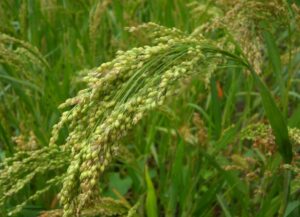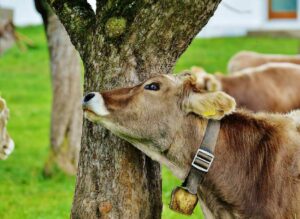John K. Bernard
Corn silage and alfalfa are considered the King and Queen of forages and are ideal for feeding cattle, but there are situations where neither is the best choice agronomically. For example, excess rain and flooding this last spring prevented planting for many necessitating the need to plant an alternative forage. Another example is where irrigation is either not available or limited and a different forage option is needed to supply a more reliable source of forage due to unreliable rainfall patterns.
Alternative forages are forages that are used in place of corn or alfalfa. There are many choices for producers to select from and no one is “ideal” for all locations. Some alternative summer annual forages include forage sorghum, grain sorghum, sorghum sudan grass, pearl millet, sudan grass, Teff, forage soybeans, crabgrass and others. Each has its own unique niche for planting and yield and quality potential. Some better suited for feeding animals with lower nutrients requirements but are commonly fed to lactating cows with high production. Some of these alternative forages have research on how they can be used for feeding lactating cows, but others have more limited research. Determining which one is appropriate depends on your needs and what is best suited for growing in your area. Below are some points to consider when making a decision to plant alternative forages and selecting which one is best for your operation.
- Will the alternative forage grow in your soils and environments? Some alternative forages are more tolerant of lower fertility and/or poorly drained soils. If soil fertility is low and will not support acceptable yields of corn or alfalfa without more inputs per acre, planting an alternative forage while soil pH and fertility are improved, or drainage is installed may provide a more economical option.
- If adequate moisture is not available throughout the growing season either due to a mild drought or lack of irrigation to support acceptable yields of corn and alfalfa, drought tolerant alternative forages many be a desirable option to produce the tonnage needed for feeding your herd.
- In some regions, the growing season is just long enough for another crop between corn and a winter annual. There are several alternative forages that could be planted to grow additional forage to insure adequate supplies.
- In some situations, an alternative forage that has a lower energy density can be produced at a lower cost per ton for feeding animals that do not need either corn silage or alfalfa. Given the increased cost of straw and other fillers in some regions, this may be a better alternative.
- Before finalizing the selection of any alternative forage, consider weed and pest control programs to make sure there are no issues with herbicides used on the previous crop that would present a problem with germination and growth of the alternative forage. The same is true for designing a weed control program for the alternative crop to prevent issues with the following crop.
- Each crop is susceptible to specific diseases and insect infestations, so be sure to consider these potential issues as you make a final selection
Once a decision has been made, review the results of university and seed company variety test to select the best variety for planting. Follow fertility and planting recommendations for your region to produce a good crop. Like any forage, harvesting at the correct stage of maturity is key to achieving the desired forage quality. Some forages are easier to ensile or harvest as hay, but others require more management. For example, millet must be wilted to above 35% DM if harvested as silage or baleage to minimize poor fermentation which will result in poor intake and animal performance.
Implementation
Alternative forages provide opportunities to produce needed tonnage to meet animal needs as well as possibility reduce fed cost in certain situations. Like any decision, producers should take time to do their homework to determine if an alternative forage works in their forage program, which alternative forage should be planted, what are the disease and insect risk/challenges, and when to harvest to optimize yield and quality.
About the author
Dr. John K. Bernard is a professor in the Department of Animal and Dairy Science at the University of Georgia Tifton Campus. He has a research and extension appointment in dairy nutrition and management. His applied research program addresses issues related to forages, by-products, specialty ingredients, additives and heat stress. During his career, Dr. Bernard has published more than 100 referred publications and numerous extension bulletins and newsletters. In addition to his academic responsibilities, John provides oversight of daily operations and budgets of the dairy, beef and farm units at Tifton. jbernard@uga.edu











